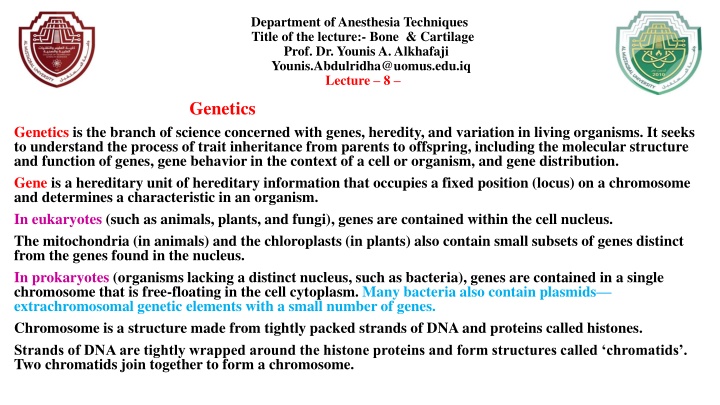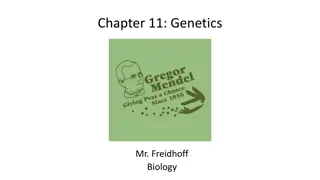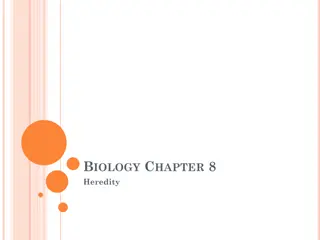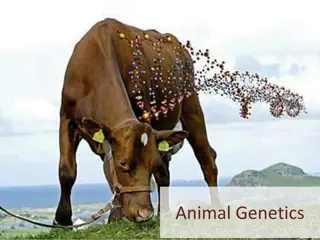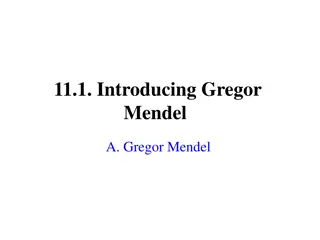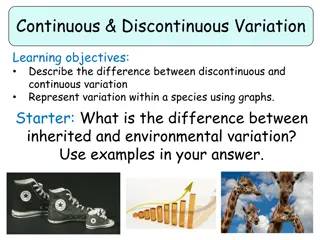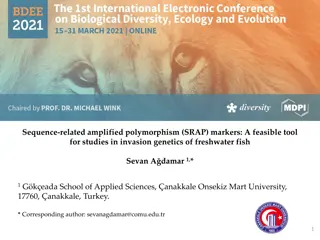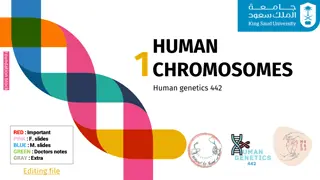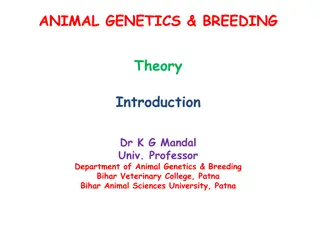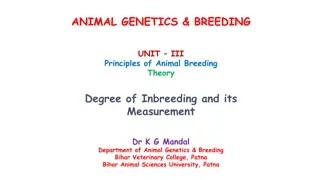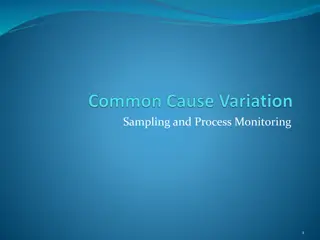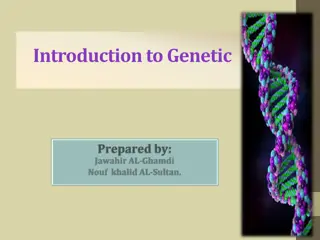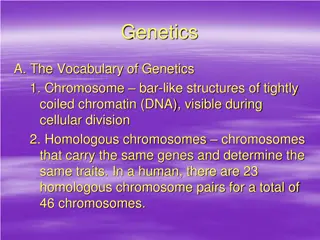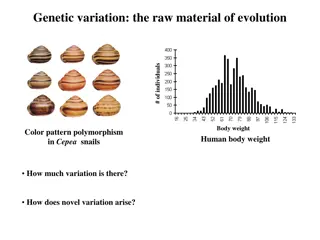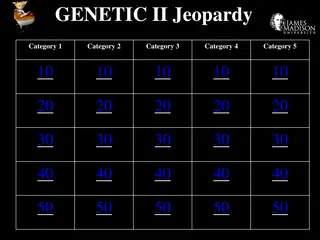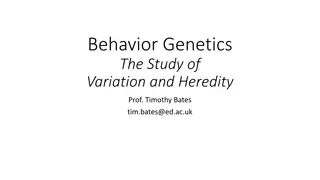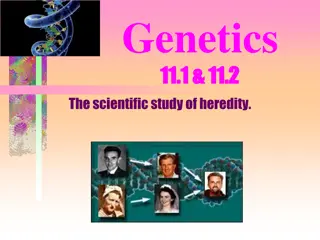Genetics: Branch of Science Concerned with Genes, Heredity, and Variation
Genetics is a key lecture topic in the Department of Anesthesia Techniques. Explore the study of genes, heredity, and variation in living organisms led by Prof. Dr. Younis A. Alkhafaji.
Download Presentation

Please find below an Image/Link to download the presentation.
The content on the website is provided AS IS for your information and personal use only. It may not be sold, licensed, or shared on other websites without obtaining consent from the author.If you encounter any issues during the download, it is possible that the publisher has removed the file from their server.
You are allowed to download the files provided on this website for personal or commercial use, subject to the condition that they are used lawfully. All files are the property of their respective owners.
The content on the website is provided AS IS for your information and personal use only. It may not be sold, licensed, or shared on other websites without obtaining consent from the author.
E N D
Presentation Transcript
Department of Anesthesia Techniques Title of the lecture:- Bone & Cartilage Prof. Dr. Younis A. Alkhafaji Younis.Abdulridha@uomus.edu.iq Lecture 8 Genetics Genetics is the branch of science concerned with genes, heredity, and variation in living organisms. It seeks to understand the process of trait inheritance from parents to offspring, including the molecular structure and function of genes, gene behavior in the context of a cell or organism, and gene distribution. Gene is a hereditary unit of hereditary information that occupies a fixed position (locus) on a chromosome and determines a characteristic in an organism. In eukaryotes (such as animals, plants, and fungi), genes are contained within the cell nucleus. The mitochondria (in animals) and the chloroplasts (in plants) also contain small subsets of genes distinct from the genes found in the nucleus. In prokaryotes (organisms lacking a distinct nucleus, such as bacteria), genes are contained in a single chromosome that is free-floating in the cell cytoplasm. Many bacteria also contain plasmids extrachromosomal genetic elements with a small number of genes. Chromosome is a structure made from tightly packed strands of DNA and proteins called histones. Strands of DNA are tightly wrapped around the histone proteins and form structures called chromatids . Two chromatids join together to form a chromosome.
Department of Anesthesia Techniques Title of the lecture:- Bone & Cartilage Prof. Dr. Younis A. Alkhafaji Younis.Abdulridha@uomus.edu.iq Lecture 8 Nucleic acids are the carriers of genetic information, in all living organisms. Two major classes of nucleic acids:- Deoxyribonucleic acid (DNA): carrier of genetic information Ribonucleic acid (RNA): an intermediate in the expression of genetic. The monomeric units for nucleic acids are nucleotides. Nucleotides are made up of three structural subunits 1.Sugar: ribose in RNA- deoxyribose in DNA 2.Nitrogenous base 3.Phosphate Note:- Nucleotides = nucleoside + phosphate Nucleosides = Nitrogenous base + sugar Sugar= Ribose (in RNA) , Deoxyribose(in DNA) Nitrogenous base Purine and Pyrimidines
Department of Anesthesia Techniques Title of the lecture:- Bone & Cartilage Prof. Dr. Younis A. Alkhafaji Younis.Abdulridha@uomus.edu.iq Lecture 8 Complementary Base Pairing The nitrogenous bases may form hydrogen bonds according to complementary base pairing: Adenine always forms two hydrogen bonds with thymine / uracil Guanine always forms three hydrogen bonds with cytosine
Department of Anesthesia Techniques Title of the lecture:- Bone & Cartilage Prof. Dr. Younis A. Alkhafaji Younis.Abdulridha@uomus.edu.iq Lecture 8 DNA Deoxyribonucleic acid is a coiled double helix carrying hereditary information of the cell. Erwin Chargraff (1950 s) determined that the amount of A T and amount of C G in DNA; called Chargaff s Rule Watson & Crick discovered double helix shape of DNA & built the 1st model DNA made of 4 nitrogen-containing bases held together by weak hydrogen bonds Purines (double carbon-nitrogen rings) include adenine (A) and guanine (G) Pyrimidines (single carbon-nitrogen rings) include thymine (T) and cytosine (C) Base pairing means a purine bonds to a pyrimidine (Example: A T and C G) Sides made of pentose (5-sided) sugars attached to phosphate groups by phosphodiester bonds Pentose sugar called Deoxyribose Coiled, double stranded molecule known as double helix Make up chromosomes in the nucleus Subunits of DNA called nucleotides Nucleotides contain a phosphate, a Deoxyribose sugar, and one nitrogen base (A,T,C, or G)
Department of Anesthesia Techniques Title of the lecture:- Bone & Cartilage Prof. Dr. Younis A. Alkhafaji Younis.Abdulridha@uomus.edu.iq Lecture 8 RNA Ribonucleic acid Single stranded molecule Found in nucleus & cytoplasm Contains ribose sugar Contains the nitrogen base uracil (U) instead of thymine So Apairs with U Base pairings areA-U and C-G Three types of RNA exist (mRNA, tRNA, & rRNA) mRNA Messenger RNA Single, uncoiled, straight strand of nucleic acid Found in the nucleus & cytoplasm Copies DNA s instructions & carries them to the ribosomes where proteins can be made mRNA s base sequence is translated into the amino acid sequence of a protein Three consecutive bases on mRNA called a codon (e.g. UAA, CGC, AGU)
Department of Anesthesia Techniques Title of the lecture:- Bone & Cartilage Prof. Dr. Younis A. Alkhafaji Younis.Abdulridha@uomus.edu.iq Lecture 8 t-RNA (Transfer RNA ) Single stranded molecule containing 80 nucleotides in the shape of a cloverleaf Carries amino acids in the cytoplasm to ribosomes for protein assembly Three bases on t-RNA that are complementary to a codon on mRNA are called anticodons (e.g. codon- UUA; anticodon- AAU) Amino Acid attachment site across from anticodon site on t-RNA Enters a ribosome & reads mRNA codons and links together correct sequence of amino acids to make a protein. r-RNA Ribosomal RNA Globular shape Helps make up the structure of the ribosomes rRNA & protein make up the large & small subunits of ribosomes Ribosomes are the site of translation (making polypeptides) Aids in moving ribosomes along the mRNA strand as amino acids are linked together to make a protein
Department of Anesthesia Techniques Title of the lecture:- Bone & Cartilage Prof. Dr. Younis A. Alkhafaji Younis.Abdulridha@uomus.edu.iq Lecture 8 DNA Replication Replication is the process by which a double-stranded DNA molecule is copied to produce two identical DNA molecules. Occurs during S phase of interphase before cell division Each strand of the double-stranded DNA molecule serves as a template for the synthesis of the new DNA molecule. DNA are antiparallel they have opposite directions The double stranded DNA molecule should be unwounded prior to undergoing the replication. DNA replication occurs in a semi-conservative manner which means that each newly-synthesized, double- stranded DNA molecule contains an old DNA molecule. The process of DNA replication, include three steps are initiation, elongation and termination. There were three basic models for DNA replication
Department of Anesthesia Techniques Title of the lecture:- Bone & Cartilage Prof. Dr. Younis A. Alkhafaji Younis.Abdulridha@uomus.edu.iq Lecture 8 1. Conservative: In this model, DNA replication results in one molecule that consists of both original DNA strands (identical to the original DNA molecule) and another molecule that consists of two new strands (with exactly the same sequences as the original molecule). 2. Semi-conservative: In this model, whole double-stranded molecule could act as a template for the synthesis of a completely new double-stranded molecule, complementary strand. This results in two DNA molecules with one original strand and one new strand. 3. Dispersive: In the dispersive model, DNA replication results in two DNA molecules that are mixtures, or hybrids, of parental and daughter DNA. In this model, each individual strand is a patchwork of original and new DNA
Department of Anesthesia Techniques Title of the lecture:- Bone & Cartilage Prof. Dr. Younis A. Alkhafaji Younis.Abdulridha@uomus.edu.iq Lecture 8 Steps of DNA replication Initiation Begins at special sites along DNA called origins of replication where 2 strands open & separate making a replication fork DNA helicase (enzyme) uncoils & breaks the weak hydrogen bonds between complementary bases (strands separate)
Department of Anesthesia Techniques Title of the lecture:- Bone & Cartilage Prof. Dr. Younis A. Alkhafaji Younis.Abdulridha@uomus.edu.iq Lecture 8 Elongation DNA polymerase responsible creating the new strand, adds new nucleotides to the exposed bases in the 5 to 3 direction On one strand called the leading strand (built toward replication fork) completed in one piece, new DNA is synthesized continuously. Lagging strand (built moving away from the replication fork) is made in sections called Okazaki fragments. This process of replication is discontinuous as the newly created fragments are disjointed
Department of Anesthesia Techniques Title of the lecture:- Bone & Cartilage Prof. Dr. Younis A. Alkhafaji Younis.Abdulridha@uomus.edu.iq Lecture 8 Termination DNA polymerase proofreads the new DNA checking for errors and repairing them; called excision repair DNA ligase helps join Okazaki segments together Helicase recoils the two, new identical DNA molecules
